The first issue of Nagraj, a widely acclaimed character, was written by the legendary author Parshuram Sharma and illustrated by Pratap Malik. Malik successfully illustrated this character for approximately 50 issues until 1995. After that, the artistic responsibilities were taken over by the artist and author Anupam Sinha. Today, Nagraj owes much of its existence to these stalwarts of the Indian comic industry, Pratap Malik and Anupam Sinha.
Nagraj’s character is considered a mythical shape-shifting snake, inspired by historical venomous creatures. His stories are a rich blend of mythology, imagination, magic, and science fiction. Many fans believe that over time, Nagraj comics have developed their own unique serpent lore, which is unparalleled in popular Indian perceptions of snakes.
Originally, Nagraj was conceived as an antagonist representing international terrorism. Interestingly, in his debut issue, Nagraj was portrayed by the villainous scientist Professor Nagamani as a weapon of international terrorism. In this initial mission, Nagraj was assigned the task of stealing the idol of the goddess from a protected temple by the elderly sage Gorakhnath Baba, who had more than 300 years of mysterious existence, along with tribal devotees, snakes, and other mystical elements.
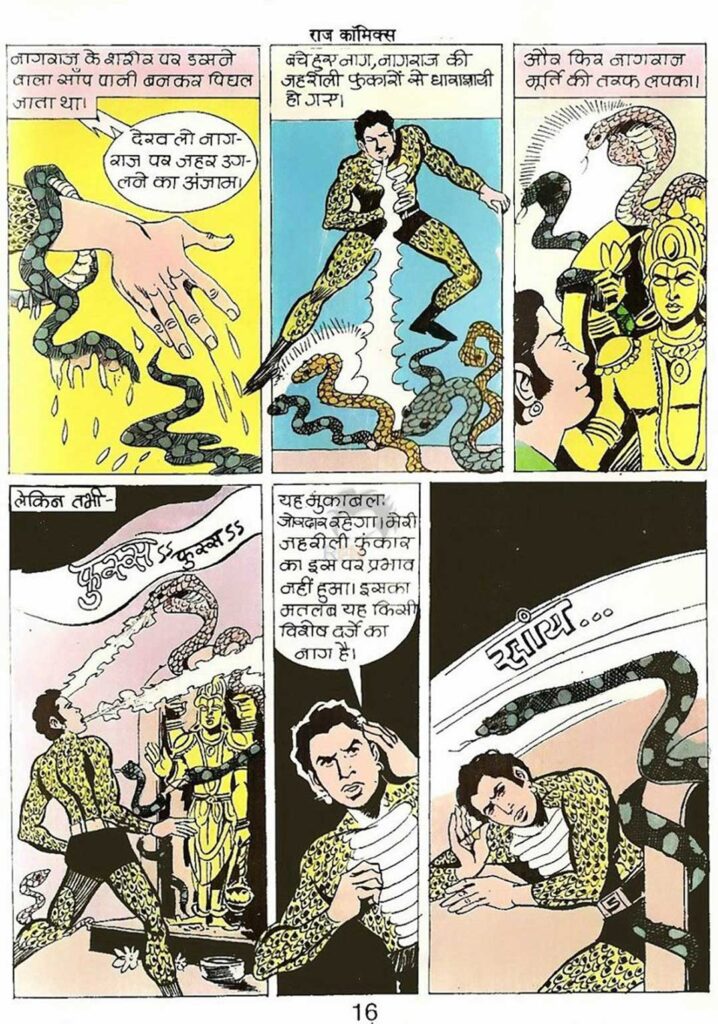
Although Nagraj succeeded in his mission, he faced defeat in a showdown with the enigmatic and powerful Gorakhnath and his mystical black snakes. Gorakhnath delved into Nagraj’s mind and discovered that Professor Nagamani had implanted a device in his head as a capsule to control his thoughts. Through surgical intervention, Gorakhnath removed the capsule, freeing Nagraj from Professor Nagamani’s control. Subsequently, Nagraj became a disciple of Baba Gorakhnath, pledging to eliminate crime and terrorism from the Earth. Since then, Nagraj has undertaken three world tours, defeating numerous villains and terrorists along the way.
In ancient times, when gods freely roamed the Earth without any restrictions, there existed a kingdom called Takshakanagar. It was ruled by King Takshakaraj and Queen Lalita. The royal couple had no worries except for one concern – they had no offspring. The absence of a prince or princess made the sole heir to the throne a potential successor named Nagpasha.
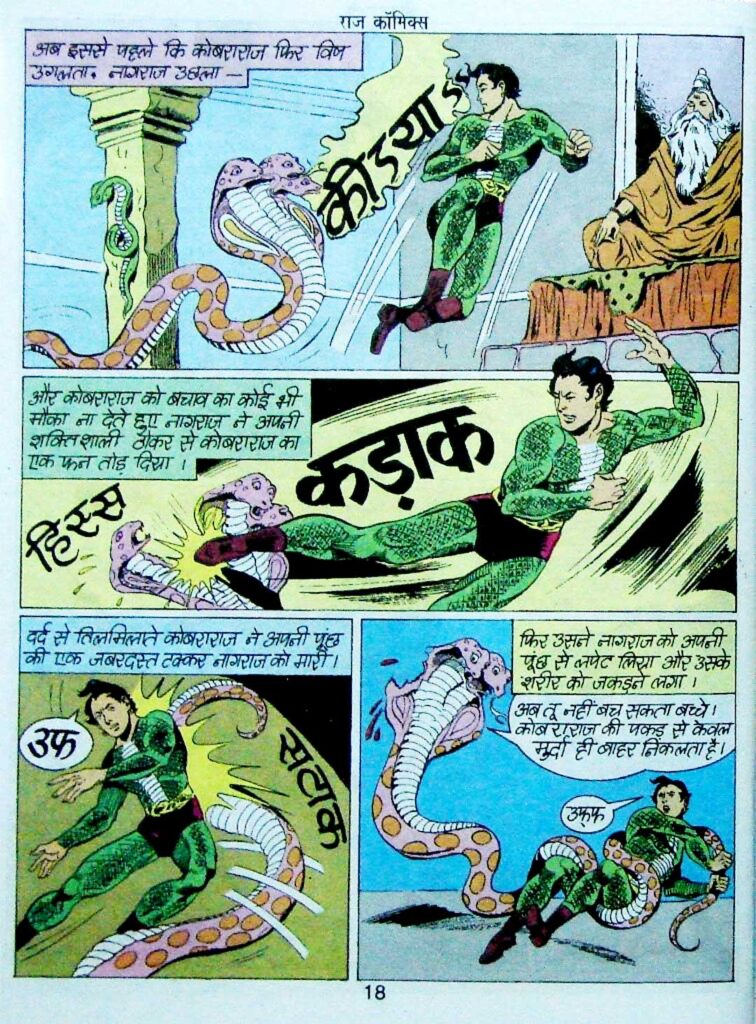
Nagpasha, the younger brother of the emperor, led a life of carefree magnificence upon realizing that he was the only potential heir to the throne. Unburdened by worries, he lived a grand life, knowing that he was the likely inheritor of the royal seat.
As time passed, the queen began to feel saddened by the absence of her child. The king, understanding the cause of the queen’s melancholy, also became distressed. The royal couple performed rituals and prayers to their family deity, Dev Kaljayi, seeking blessings. Dev Kaljayi, aware of their sorrow, granted them a boon one day – a blessing to conceive a great heir.
The blessing came true, and soon the queen became pregnant, bringing joy to the entire kingdom except Nagpasha. The birth of this child meant losing the chance to inherit the throne. Before the child was born, Nagpasha decided to eliminate the potential threat by taking its life.

One day, as the queen was going for the worship of Dev Kaljayi, Nagpasha replaced the divine offering in the covered plate with a dead snake. Infuriated, the snake deity poisoned the queen with its venomous breath, causing her to lose consciousness. Despite the king’s plea for forgiveness and a request to revive his wife, the deity refused. Devastated, the king attempted suicide. Unable to bear the devotee’s death, Dev Kaljayi suggested a way to save the queen’s life.
He gave the king a gem and instructed him to place it on the queen’s body to neutralize the poison. The gem would redirect the venom away from the queen’s body but, due to the adverse effects of the poison, she would lose her reproductive abilities.
The news of the queen’s condition spread sorrow throughout the kingdom, and the king also became despondent. Nagpasha, however, was delighted that he remained the sole heir. When the child was born, it appeared lifeless – its entire body was blue, showing no signs of life. Following Hindu tradition, the newborn was cast into the river since it was considered dead. (In Hindu customs, when a newborn is stillborn or dies in infancy, the body is floated in a river.)
Nagpasha jubilantly approached Dev Kaljayi, who was a deity in the form of a majestic two-headed serpent guarding the royal treasures. He arrogantly claimed his right to the royal treasures, declaring himself the sole heir to the throne. However, Dev Kaljayi rejected his demand, stating that the true heir to the throne was alive, and when the time comes, the treasures would be handed over to the rightful successor. Infuriated, Nagpasha raised his sword against the deity, but with a swift movement of the serpent’s tail, he was knocked away.
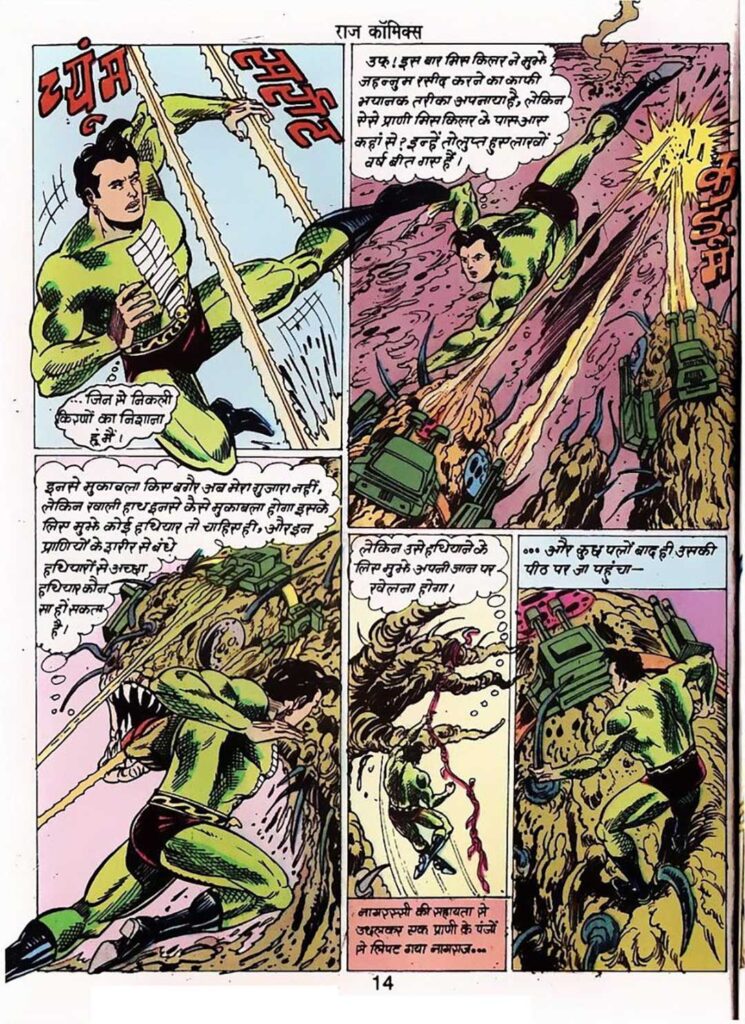
In his rage, Nagpasha lifted his sword against the deity, but the massive serpent’s tail swiftly knocked him aside. Fuming with anger, Nagpasha drew his sword in defiance, but before he could strike, the colossal serpent swiftly flicked its tail, sending him flying. Nagpasha landed on two containers – one filled with extremely poisonous venom (Halahala, considered the deadliest poison by Hindus), which corroded his face upon contact, and the other containing the elixir of immortality, turning him into an immortal being.
The simultaneous effects of both substances transformed Nagpasha into an immortal venomous creature. Unable to bear the changes in his body, he fell unconscious. The deity’s actions had made Nagpasha an eternal venomous being, experiencing the excruciating pain of the poison but unable to perish.
When King was informed about these events by Dev Kaljayi, he learned that his son was not dead, and he became aware of the potential dangers to his life. Therefore, he ordered the wise sage Vedacharya, who was well-versed in the knowledge of talismans, to protect the treasures in such a way that only his son could break it. With the assistance of Dev Kaljayi, Vedacharya prepared a talisman to ensure that not only could no one other than the king’s son break it, but also the immortal Nagpasha.
When Nagpasha regained consciousness, he realized that the treasure was lost. Enraged, he came in a fit of anger and murdered the king and queen.
On the other hand, in a lifeless state, the infant drifted into the river and got entangled in the reeds. There, the baby remained stranded for a long time.
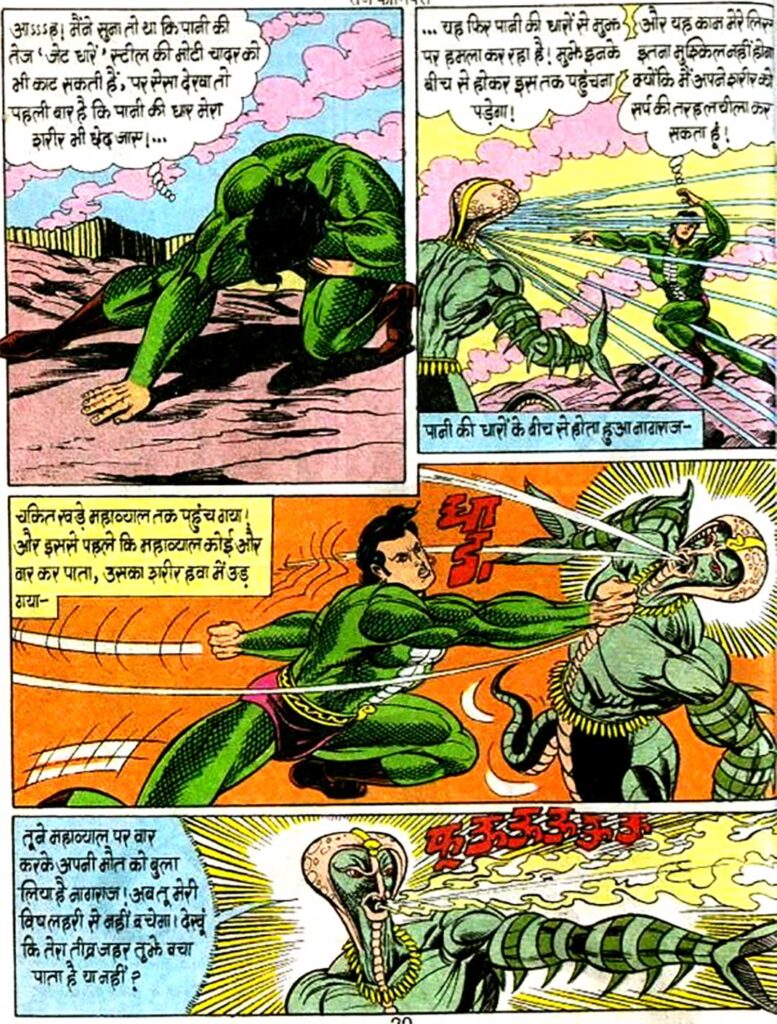
Meanwhile, the serpent deity Dev Kaljayi appeared in the dreams of King Maniraj and Queen Manika, the rulers of the kingdom of Ojhal on Nagadweep, a hidden island in the Indian Ocean, where immortal shape-shifting serpents resided. They revealed the location of the infant and instructed them to cure the child. Following their guidance, the rulers located the child and discovered that the infant possessed divine venom surpassing even the great serpent sage Kaladoot, indicating the presence of a divine elixir.
Initially uncertain if they could heal the child, the royal physicians gained assurance as Dev Kaljayi had personally directed the king to seek their assistance. They successfully treated the infant, and it was revealed that the child had a divine elixir, more potent than even Kaladoot’s venom. Following the island’s rules that prohibited the entry of outsiders, the king decided to keep the child’s presence concealed.
Many years passed, and the results of the treatment began to show. However, there was still no sign of any life activity in the child, although the color of the infant slowly started changing to green. The king informed the queen about this development, and they decided to adopt the child since they did not have any offspring of their own. The nefarious sorcerer Vishandhar, who aimed to become the ruler of the island, learned of their decision. Fearful of the great serpent sage Kaladoot, Vishandhar attacked the hidden area where the child was kept and fled with the child. However, due to the fear of divine wrath, he chose not to harm the child and returned it to the same thicket by the river where it was found.
His plan failed as the queen soon conceived and gave birth to a daughter named Visarpi.
Vishandhar never learned that the child he abandoned had regained consciousness. First, the child’s face and then the body transformed into a normal human appearance, and he began to cry. A priest from a nearby temple saw him and gave him the name Professor Nagamani, who was wandering in the jungle in search of snakes. For unknown reasons, the priest narrated a false story that the child was born to a woman who had been assaulted, was a devotee of the serpent deity, and had received the blessing to become a shape-shifting serpent. He requested Nagamani to take care of the child in a way that he could avenge his mother.
Nagamani understood that the priest was lying but decided to take the child with him. Blood tests revealed that the child’s white blood cells were actually microscopic snakes instead of blood. The child possessed extraordinary healing powers and was extremely venomous. Nagamani nurtured the child, who eventually transformed into Nagraj, the serpent king.
Nagraj was presented to the world as a creation of Professor Nagamani. He was being developed into a specialized assassin, and the primary plan was to auction Nagraj to the highest bidder among global criminals and terrorist groups.
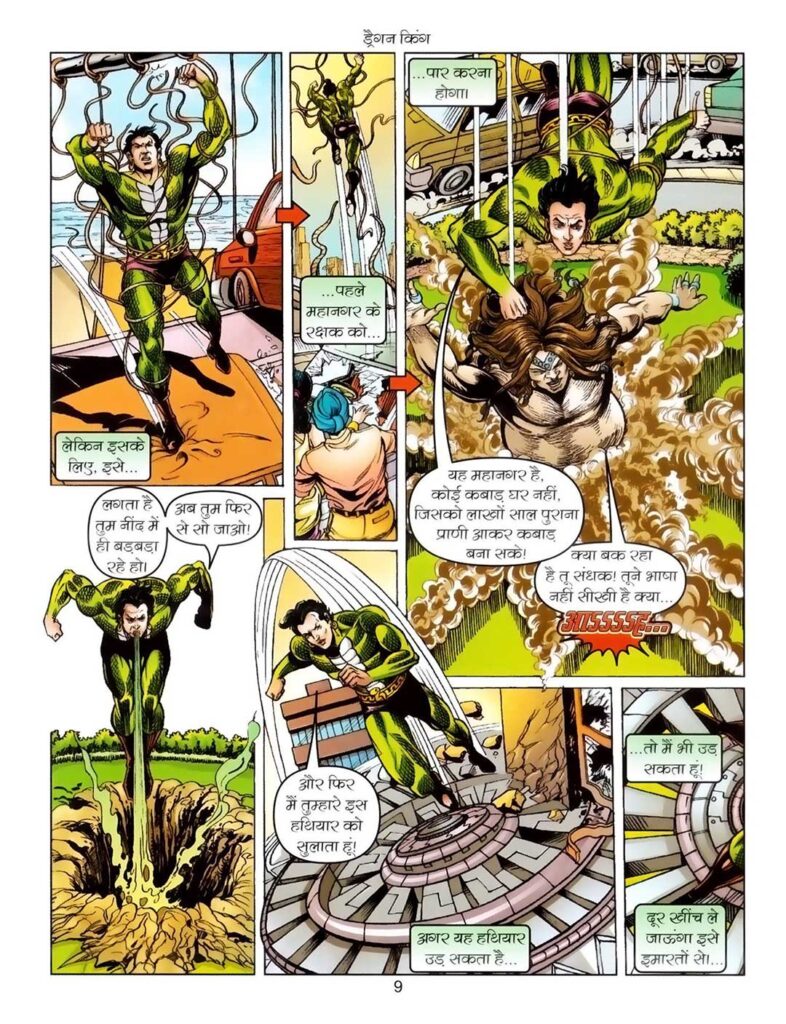
Professor Nagamani used Nagraj in his other experimental projects and for international terrorism. Nagamani always claimed that Nagraj’s venomous powers were developed by incorporating snake venom components into his blood. He asserted that Nagraj’s venom was a result of the bites of 1000 different snake species, and his powers were enhanced through a process involving the ashes of a dead shape-shifting snake. In reality, Nagraj’s venom was more potent than any snake species, as it was mystical.
Drawing from Hindu mythology, Nagraj derived his power from tiny snakes living in his blood cells instead of white blood cells. His venom had supernatural properties, including the ability to cure deadly snake bites immediately and various extraordinary powers like venomous breath, venomous cries, and the ability to morph into different shapes, sizes, and even release separate entities or threads according to his imagination.
According to the narrative, Nagraj, having more than the shape-shifting abilities, gained power from the microscopic snakes living in his blood cells and had unique venom. His venom contained the potency to dissolve bodies like potassium cyanide, and Nagraj was considered more venomous than any snake species.
In his first mission, Nagraj was sold for ten lakhs, with the goal of obtaining an ancient idol. Nagraj succeeded, but then he faced defeat by the ascetic Shubha Gorakhnath, who freed his mind from the control of Professor Nagamani. Awaking in a new peaceful world created by Gorakhnath, Nagraj vowed to end terrorism worldwide and moved forward to achieve his objective.
In the early stages, Nagraj’s powers were limited, and sometimes he would lose to powerful human adversaries, temporarily losing consciousness. His strength was somewhat comparable to humans, and he would occasionally be overpowered by human opponents. However, over the years, Nagraj became so powerful that he could not only stop falling cars effortlessly but also throw objects into outer space.
Nagraj, now living as Raj, an employee of a fictional TV channel with secret ownership in a metropolitan city, had become immensely powerful. He could easily catch falling cars and casually throw objects into outer space, showcasing his supernatural abilities.
6 Comments
Pingback: Blast from the Past: Nagraj & Dhruva’s Wild Ride in ‘Pralay’ | comicsbio.com
Pingback: Kuttapanti – Doga’s Emotional & Action-Packed Battle for Man’s Best Friend | comicsbio.com Kuttapanti Review – Doga’s Action, Emotion & Fight for Dogs | Raj Comics
Pingback: Nagraj and Dracula Comic Review | comicsbio.com
Pingback: Nagraj and Dracula Comic Review | comicsbio.com
Pingback: Nagraj vs See-Through – Ichchadhari Raj Comics Review | comicsbio.com
I don’t think the title of your article matches the content lol. Just kidding, mainly because I had some doubts after reading the article. https://accounts.binance.info/zh-CN/register-person?ref=WFZUU6SI